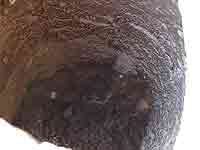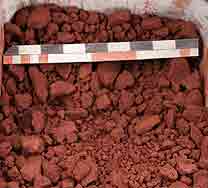The June 14 smelt was undertaken with the assistance of Ken
Cook and Sam Falazone. It proved quite unusual,
in that there was extremely little effect on the structure of the smelter
itself. The image shows the inside surface of the smelter, with the area
around the tuyere in the upper right.
First, there is very little erosion of the wall material. The area above
the tuyere, normally sustains damage, but in this case you can see that
the wall has hardly been effected. Curiously, what erosion that took place
was just bellow the tuyere. The tuyere itself was also only slightly effected,
and other than a slight rounding of the square tip, still remains the same
distance proud of the wall surface as at the start of the smelt.
Second, very little material, either slag or partially sintered ore, can
be seen remaining attached to the inner wall surface. In many past smelts,
a considerable build up of these two materials can be seen. |
 |
